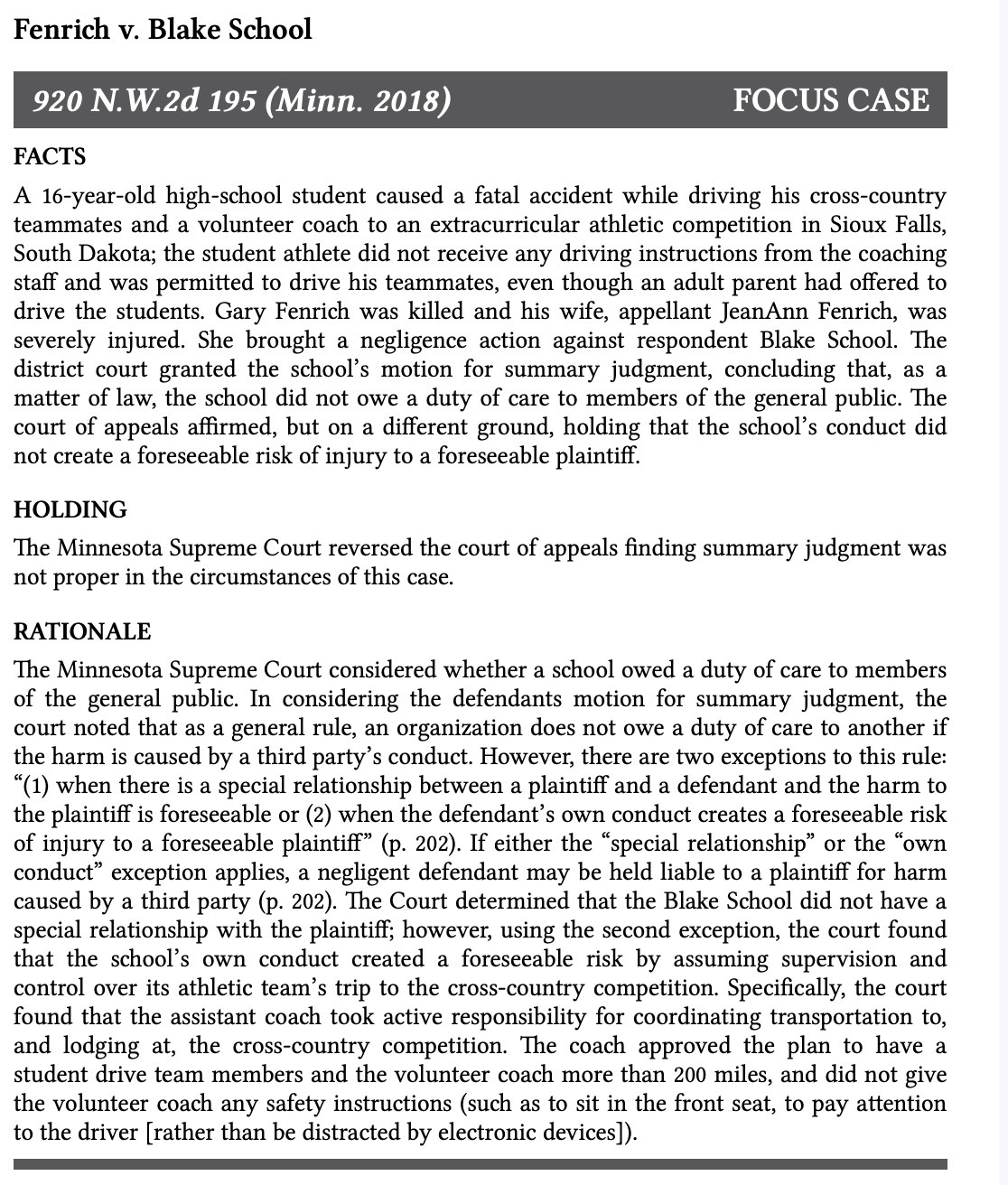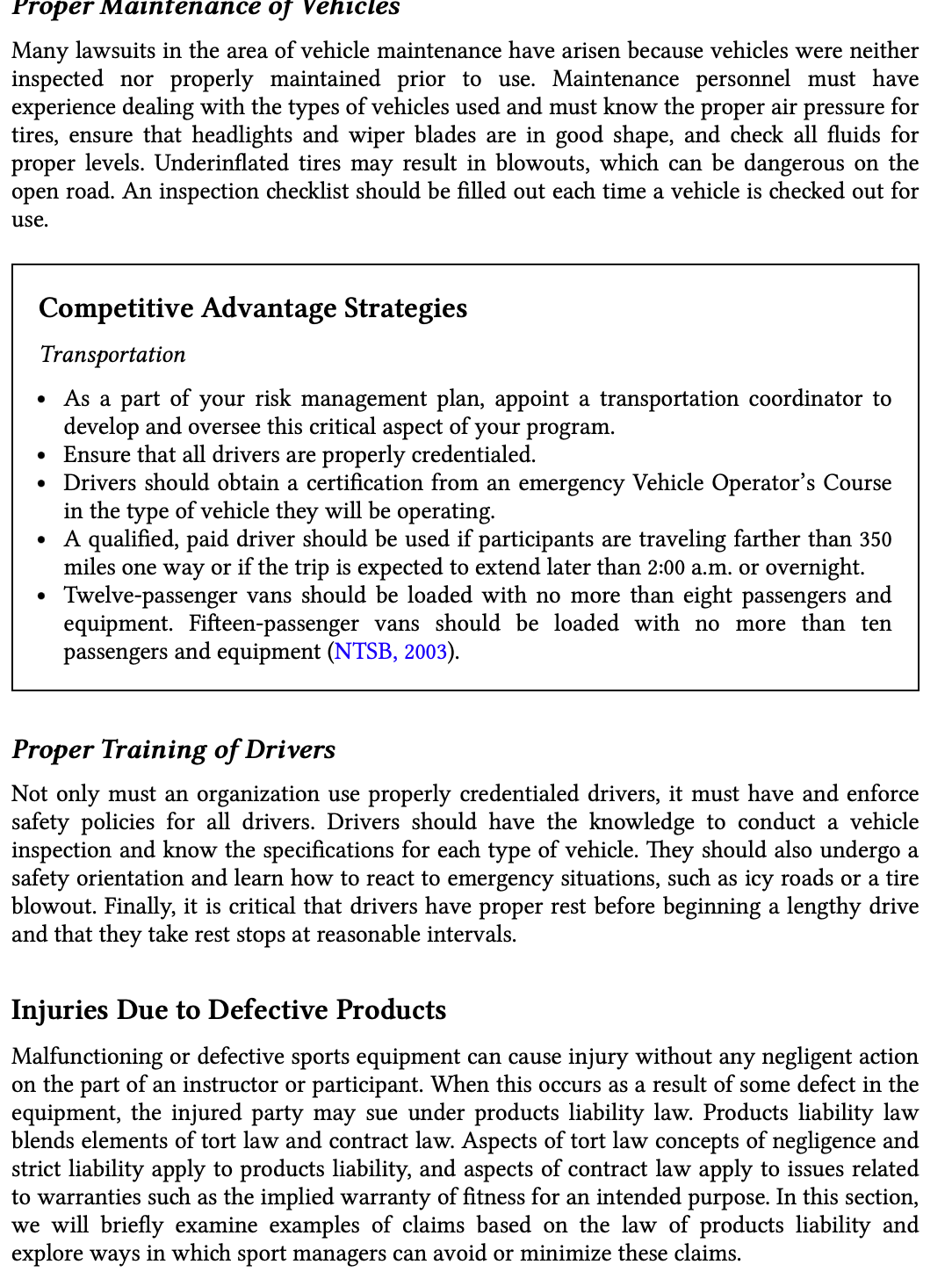Answered step by step
Verified Expert Solution
Question
1 Approved Answer
Questions: Facts of the case: Procedural history: Holding: Rationale: Legal concepts: Consequences: My own critical reflection: Practical application for sport administrator: FACTS A 16-year-old high-school


Questions:
- Facts of the case:
- Procedural history:
- Holding:
- Rationale:
- Legal concepts:
- Consequences:
- My own critical reflection:
- Practical application for sport administrator:
FACTS A 16-year-old high-school student caused a fatal accident while driving his cross-country teammates and a volunteer coach to an extracurricular athletic competition in Sioux Falls, South Dakota; the student athlete did not receive any driving instructions from the coaching staff and was permitted to drive his teammates, even though an adult parent had offered to drive the students. Gary Fenrich was killed and his wife, appellant JeanAnn Fenrich, was severely injured. She brought a negligence action against respondent Blake School. The district court granted the school's motion for summary judgment, concluding that, as a matter of law, the school did not owe a duty of care to members of the general public. The court of appeals affirmed, but on a different ground, holding that the school's conduct did not create a foreseeable risk of injury to a foreseeable plaintiff. HOLDING The Minnesota Supreme Court reversed the court of appeals finding summary judgment was not proper in the circumstances of this case. RATIONALE The Minnesota Supreme Court considered whether a school owed a duty of care to members of the general public. In considering the defendants motion for summary judgment, the court noted that as a general rule, an organization does not owe a duty of care to another if the harm is caused by a third party's conduct. However, there are two exceptions to this rule: "(1) when there is a special relationship between a plaintiff and a defendant and the harm to the plaintiff is foreseeable or (2) when the defendant's own conduct creates a foreseeable risk of injury to a foreseeable plaintiff" (p. 202). If either the "special relationship" or the "own conduct" exception applies, a negligent defendant may be held liable to a plaintiff for harm caused by a third party (p. 202). The Court determined that the Blake School did not have a special relationship with the plaintiff; however, using the second exception, the court found that the school's own conduct created a foreseeable risk by assuming supervision and control over its athletic team's trip to the cross-country competition. Specifically, the court found that the assistant coach took active responsibility for coordinating transportation to, and lodging at, the cross-country competition. The coach approved the plan to have a student drive team members and the volunteer coach more than 200 miles, and did not give the volunteer coach any safety instructions (such as to sit in the front seat, to pay attention to the driver [rather than be distracted by electronic devices]). Many lawsuits in the area of vehicle maintenance have arisen because vehicles were neither inspected nor properly maintained prior to use. Maintenance personnel must have experience dealing with the types of vehicles used and must know the proper air pressure for tires, ensure that headlights and wiper blades are in good shape, and check all fluids for proper levels. Underinflated tires may result in blowouts, which can be dangerous on the open road. An inspection checklist should be filled out each time a vehicle is checked out for use. Competitive Advantage Strategies Transportation - As a part of your risk management plan, appoint a transportation coordinator to develop and oversee this critical aspect of your program. - Ensure that all drivers are properly credentialed. - Drivers should obtain a certification from an emergency Vehicle Operator's Course in the type of vehicle they will be operating. - A qualified, paid driver should be used if participants are traveling farther than 350 miles one way or if the trip is expected to extend later than 2:00 a.m. or overnight. - Twelve-passenger vans should be loaded with no more than eight passengers and equipment. Fifteen-passenger vans should be loaded with no more than ten passengers and equipment (NTSB, 2003). Proper Training of Drivers Not only must an organization use properly credentialed drivers, it must have and enforce safety policies for all drivers. Drivers should have the knowledge to conduct a vehicle inspection and know the specifications for each type of vehicle. They should also undergo a safety orientation and learn how to react to emergency situations, such as icy roads or a tire blowout. Finally, it is critical that drivers have proper rest before beginning a lengthy drive and that they take rest stops at reasonable intervals. Injuries Due to Defective Products Malfunctioning or defective sports equipment can cause injury without any negligent action on the part of an instructor or participant. When this occurs as a result of some defect in the equipment, the injured party may sue under products liability law. Products liability law blends elements of tort law and contract law. Aspects of tort law concepts of negligence and strict liability apply to products liability, and aspects of contract law apply to issues related to warranties such as the implied warranty of fitness for an intended purpose. In this section, we will briefly examine examples of claims based on the law of products liability and explore ways in which sport managers can avoid or minimize these claims
Step by Step Solution
There are 3 Steps involved in it
Step: 1

Get Instant Access to Expert-Tailored Solutions
See step-by-step solutions with expert insights and AI powered tools for academic success
Step: 2

Step: 3

Ace Your Homework with AI
Get the answers you need in no time with our AI-driven, step-by-step assistance
Get Started


